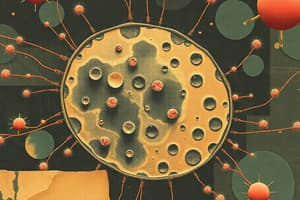Podcast
Questions and Answers
What happens to blood as it flows through the lungs?
What happens to blood as it flows through the lungs?
- It increases in volume.
- It acquires oxygen. (correct)
- It loses carbon dioxide.
- It becomes deoxygenated.
Where does the blood pick up oxygen in the lungs?
Where does the blood pick up oxygen in the lungs?
- In the capillaries.
- In the trachea.
- In the alveoli. (correct)
- In the bronchi.
What is the primary purpose of blood passing through the lungs?
What is the primary purpose of blood passing through the lungs?
- To remove waste products.
- To deliver nutrients to muscles.
- To regulate temperature.
- To acquire oxygen for cells. (correct)
How does blood flow through the body and lungs?
How does blood flow through the body and lungs?
What do cells require that blood acquires in the lungs?
What do cells require that blood acquires in the lungs?
What is the primary role of carrier proteins in a cell?
What is the primary role of carrier proteins in a cell?
How do ion channels function in cellular transport?
How do ion channels function in cellular transport?
What process do carrier proteins primarily utilize for transporting substances?
What process do carrier proteins primarily utilize for transporting substances?
Which of the following statements is true regarding ion channels?
Which of the following statements is true regarding ion channels?
What do facilitated diffusion and ion channels have in common?
What do facilitated diffusion and ion channels have in common?
What are the main substances that compose protoplasm?
What are the main substances that compose protoplasm?
Which of the following is NOT one of the basic substances found in protoplasm?
Which of the following is NOT one of the basic substances found in protoplasm?
Which substance is the largest component of protoplasm?
Which substance is the largest component of protoplasm?
Which combination includes all the correct basic substances of protoplasm?
Which combination includes all the correct basic substances of protoplasm?
What role do electrolytes play in protoplasm?
What role do electrolytes play in protoplasm?
What role do laminins play in the extracellular matrix?
What role do laminins play in the extracellular matrix?
What do junctions that fasten cells to one another primarily do?
What do junctions that fasten cells to one another primarily do?
Which of the following is NOT a function of intercellular junctions?
Which of the following is NOT a function of intercellular junctions?
What are the two main types of junctions that form between cells?
What are the two main types of junctions that form between cells?
What characteristic do junctions that permit the transfer of ions and other molecules share?
What characteristic do junctions that permit the transfer of ions and other molecules share?
What is the high-energy substance synthesized from liberated energy?
What is the high-energy substance synthesized from liberated energy?
Where does ATP primarily synthesize within the cell?
Where does ATP primarily synthesize within the cell?
What happens to ATP after it is synthesized?
What happens to ATP after it is synthesized?
What is the primary function of ATP in the cell?
What is the primary function of ATP in the cell?
Which of the following is NOT a function of ATP?
Which of the following is NOT a function of ATP?
Flashcards are hidden until you start studying
Study Notes
Blood Flow and Oxygen
- Blood flows through the lungs during each cycle through the body.
- Oxygen is picked up in the alveoli of the lungs.
- The oxygen is used by cells.
Protoplasm Composition
- Protoplasm is the collective name for the substances that make up a cell.
- Protoplasm is mainly composed of water, electrolytes, proteins, lipids, and carbohydrates.
Proteins
- Some proteins act as carriers for substances during facilitated diffusion.
- Some proteins are ion channels that allow for the passage of ions into or out of the cell.
- Some proteins bind to laminins.
- Laminins are large cross-shaped molecules with multiple receptor domains in the extracellular matrix.
Intercellular Connections
- Junctions between cells can either fasten cells to each other or to surrounding tissues.
- Junctions between cells can permit material transfer from one cell to another.
ATP
- Energy is released from nutrients and used to synthesize adenosine triphosphate (ATP).
- Mitochondria synthesize ATP.
- ATP is transported out of the mitochondrion.
- ATP diffuses through the cell to release energy for cellular functions.
Studying That Suits You
Use AI to generate personalized quizzes and flashcards to suit your learning preferences.




